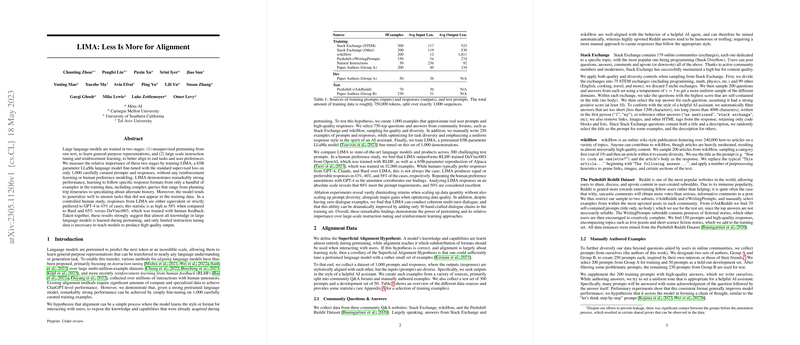An Analytical Overview of "LIMA: Less Is More for Alignment"
The paper presents a comprehensive exploration into optimizing the alignment of LLMs by challenging prevailing assumptions about the necessity of extensive instruction-tuning datasets and intricate reinforcement learning methods. The authors introduce LIMA, a 65 billion parameter LLaMa model, fine-tuned using a notably small dataset of 1,000 curated prompts and responses. This paper dissects the relative importance of pretraining and fine-tuning stages, concluding that the pretraining phase predominantly endows LLMs with their capabilities, while alignment predominantly entails learning response formats.
Methodology and Observations
The LLM alignment process typically involves two stages: unsupervised pretraining to acquire general-purpose representations, followed by extensive instruction-tuning and reinforcement learning, intended to refine output quality and user alignment. However, in LIMA's development, the latter stage is remarkably scaled down. Instead of employing large datasets and RLHF, the authors fine-tune LIMA on a carefully selected dataset sourced from community forums such as Stack Exchange and wikiHow, alongside manually crafted examples.
Key observations include:
- Performance Metrics: LIMA's responses in a controlled human paper were equivalent or preferred over GPT-4 in 43% of cases, 58% compared to Bard, and 65% against DaVinci003. Notably, this was achieved without leveraging reinforcement learning or preference modeling.
- Task Generalization: Even when exposed to a limited dataset, LIMA demonstrates commendable adeptness at generalizing to unseen tasks. This suggests that pretraining suffuses LLMs with sufficient foundational knowledge, which can be unveiled through strategically minimal alignment.
Data Considerations
A critical component of the paper is the meticulous crafting of the finetuning dataset. The authors postulate the "Superficial Alignment Hypothesis," positing that a model’s capability largely stems from pretraining, with alignment primarily refining interaction styles. They substantiate this by emphasizing the importance of diversity and response quality over sheer dataset magnitude.
- Diversity vs. Quality: Training on samples with diverse prompts and coherent responses significantly enhances performance. Experiments reveal that while an increase in data volume does not linearly raise model performance, diversity and high response quality present definitive gains.
- Dialogue and Safety: Although not initially trained with dialogue data, LIMA proved capable of engaging in coherent multi-turn dialogues. By adding a mere 30 examples of dialogue interactions, its conversational abilities were markedly enhanced, further emphasizing the hypothesis regarding pretraining’s expansiveness.
Implications and Future Directions
This work’s implications are twofold: it underscores the underestimated power of pretraining in acquiring model capabilities and presents a potential reduction in costs associated with extensive fine-tuning datasets. Scaling not by size but by careful selection and diversity signals a paradigm shift in how AI practitioners might approach LLM deployment.
Future research may delve into refining automated mechanisms for curating highly diverse and high-quality example sets. This could lead to further cost reductions and increase the accessibility of fine-tuning processes. Additionally, exploring the balance of dataset size and quality in fields beyond alignment may uncover other efficiencies and optimizations within machine learning workflows.
In conclusion, the research encapsulated in the LIMA paper challenges established norms, revealing that more streamlined approaches can rival or even surpass results achieved by traditionally resource-intensive methods. This positions the paper as a pivotal discourse in the ongoing evolution of AI alignment strategies.
